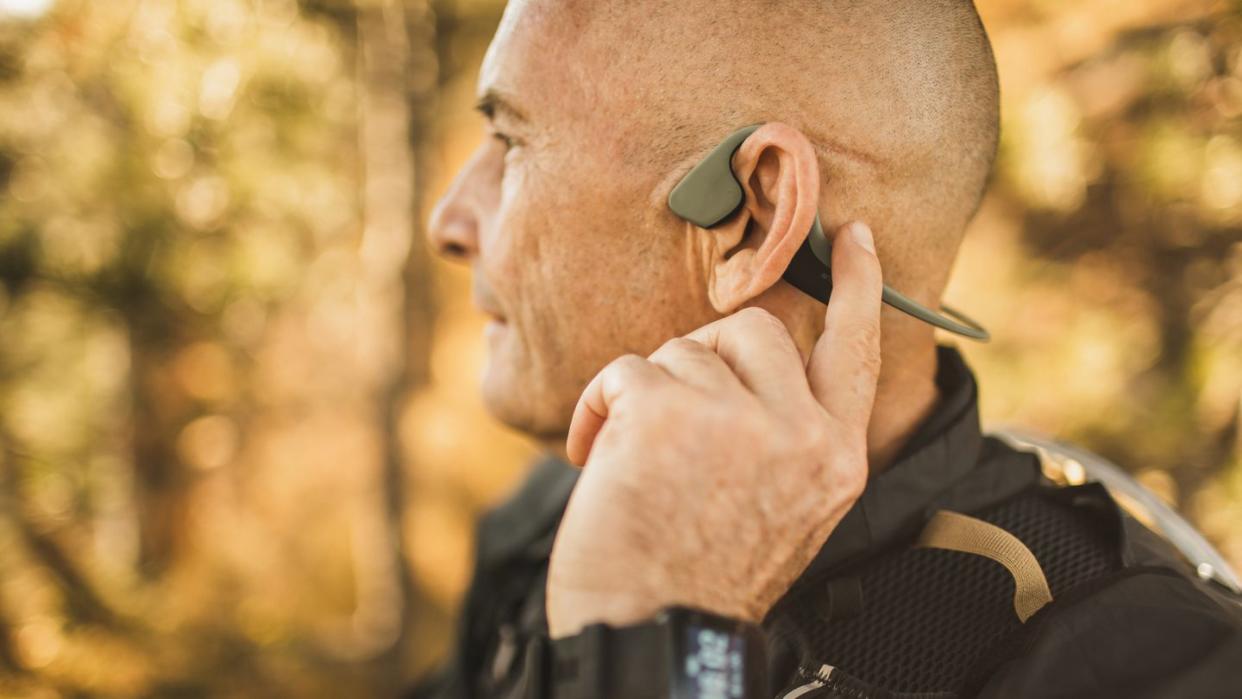Why These Odd-Looking Headphones Are Actually Excellent for Outdoor Activities

Audio technology has come such a long way in recent years that it wouldn't be outlandish to have a different pair of headphones for all your needs: A powerful set of noise-canceling headphones for your workspace, a pocket-sized pair of AirPods for your commute, and a set of sleek bone-conduction headphones for powering through your afternoon run. But how do bone-conduction headphones work and why are they designed so differently?
Bone-conduction headphones (which are separate from open-ear headphones that attach to the ears) stand apart from more traditional headphone styles. They're meant to give wearers the best of all worlds regarding comfort, convenience, and spatial awareness. Here's what you need to know about how bone-conduction headphones work, their many benefits, as well as a few potential drawbacks to their design.
What are bone-conduction headphones?
The unique form factor of bone-conduction headphones sets them apart from other audio products on the market.
“Most models hook around the top of the pinna (outer ear) and either wrap around the neck through a sports band or are connected by a thin wire,” explains Anish V. Thakkar, Au.D., director of audiology at the Los Angeles Center for Ear, Nose, Throat, and Allergy. “This allows them to stay on, even with active movement, while working out.”
Bone-conduction headphones are usually held “securely in place against your cheekbones," says Joel Smith, audio expert and founder of the music hub AllAxess.
This headphone style allows the user to listen to music, podcasts, or audiobooks, and hear what's going on in their surroundings. This interesting, around-the-head design may look like something out of a sci-fi movie, but it allows the device to transmit audio in an effective, alternative way.
How do bone-conduction headphones work?
Since bone-conduction headphones are situated alongside the ear, they work differently from other headphone styles.
“Bone-conduction headphones stimulate your inner ear through either the mastoid process of the temporal bone or more commonly, the cheekbones,” explains Dr. Thakkar. (The mastoid processes are located behind your earlobes.)
The sound produced by bone-conduction headphones may be a little different from what you're used to, but this technology has made major improvements over time.
“The audio quality with bone conduction has definitely gotten better,” says Smith. “But it still may not give you that deep, rich, and fully immersive sound you'd get from premium over-ear headphones.”
What are the benefits of bone-conduction headphones?
There is a plethora of benefits to using bone-conduction headphones, especially if you're an outdoorsy type.
Safer for Exercising
“[When wearing bone-conduction headphones,] your ears stay uncovered, so you can maintain situational awareness and hear your surroundings,” explains Smith. “This makes them great for outdoor activities or situations where you need to stay alert and pay attention to your environment.”
Because bone-conduction headphones do not block the ear canal, you can hear what's going on around you, alongside what your device is playing.
Easy to Keep Clean
From a health and cleanliness standpoint, bone-conduction headphones are an excellent choice.
“There's no irritation from having earbuds jammed into your ear canals,” Smith says, noting that bone-conduction headphones can eliminate any potential infections caused by earbuds, too.
Also, since bone-conduction headphones sit on top of the skin and never enter the ear, there's no chance of them getting dirty with earwax, making it possible to share the device with friends, adds Dr. Thakkar.
Disability-friendly
From an accessibility point of view, bone-conduction headphones are often useful for individuals with certain health conditions or disabilities.
For instance, people with conditions that affect the eardrum or ear canal may find bone-conduction headphones more comfortable, Dr. Thakker says. The Professional Hearing Center notes that people with hearing loss may benefit from bone-conduction headphones as they circumnavigate the ears altogether.
Are there any drawbacks to using bone-conduction headphones?
As helpful as bone-conduction headphones can be, there are some potential drawbacks to using these devices.
Prone to vibrating with increased volume
It's easy to increase the volume while using in-ear or over-ear headphones. However, there are limitations to volume when it comes to bone-conduction headphones.
“There are certain limits to how much gain or volume one can receive while still maintaining comfort,” Dr. Thakker explains. “It is common to feel a vibrotactile sensation on the skin itself, often described as a ‘buzzing’ or annoying vibration.”
Unsuitable for loud places
While using bone-conduction headphones allows you to exercise safer outdoors, it may be difficult to hear the audio when you pass through in loud environments.
“The sound from bone conduction would mostly be drowned out from sound entering naturally through the ear canal,” Dr. Thakker says.
Not the best in sound quality
Compared to noise-canceling earbuds that deliver rich audio quality, bone-conduction headphones may not produce the all-encompassing sound you're expecting.
“The audio can come across a bit flatter and less dynamic compared to top-tier traditional headphone models,” Smith says, noting that bass sounds might be affected in particular.
You Might Also Like

